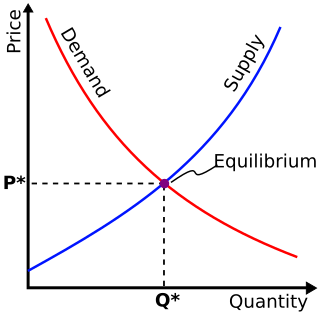Related Research Articles

Innovation is the practical implementation of ideas that result in the introduction of new goods or services or improvement in offering goods or services. ISO TC 279 in the standard ISO 56000:2020 defines innovation as "a new or changed entity, realizing or redistributing value". Others have different definitions; a common element in the definitions is a focus on newness, improvement, and spread of ideas or technologies.
In economics, internationalization or internationalisation is the process of increasing involvement of enterprises in international markets, although there is no agreed definition of internationalization. Internationalization is a crucial strategy not only for companies that seek horizontal integration globally but also for countries that addresses the sustainability of its development in different manufacturing as well as service sectors especially in higher education which is a very important context that needs internationalization to bridge the gap between different cultures and countries. There are several internationalization theories which try to explain why there are international activities.

The knowledge economy, or knowledge-based economy, is an economic system in which the production of goods and services is based principally on knowledge-intensive activities that contribute to advancement in technical and scientific innovation. The key element of value is the greater dependence on human capital and intellectual property as the source of innovative ideas, information and practices. Organisations are required to capitalise on this "knowledge" in their production to stimulate and deepen the business development process. There is less reliance on physical input and natural resources. A knowledge-based economy relies on the crucial role of intangible assets within the organisations' settings in facilitating modern economic growth.
The concept of the innovation system stresses that the flow of technology and information among people, enterprises, and institutions is key to an innovative process. It contains the interactions between the actors needed in order to turn an idea into a process, product, or service on the market.

Diffusion of innovations is a theory that seeks to explain how, why, and at what rate new ideas and technology spread. The theory was popularized by Everett Rogers in his book Diffusion of Innovations, first published in 1962. Rogers argues that diffusion is the process by which an innovation is communicated through certain channels over time among the participants in a social system. The origins of the diffusion of innovations theory are varied and span multiple disciplines.
Induced innovation is a microeconomic hypothesis first proposed in 1932 by John Hicks in his work The Theory of Wages. He proposed that "a change in the relative prices of the factors of production is itself a spur to invention, and to invention of a particular kind—directed to economizing the use of a factor which has become relatively expensive."
Leapfrogging is a concept used in many domains of the economics and business fields, and was originally developed in the area of industrial organization and economic growth. The main idea behind the concept of leapfrogging is that small and incremental innovations lead a dominant firm to stay ahead. However, sometimes, radical innovations will permit new firms to leapfrog the ancient and dominant firm. The phenomenon can occur to firms but also to leadership of countries or cities, where a developing country can skip stages of the path taken by industrial nations, enabling them to catch up sooner, particularly in terms of economic growth.
Technological change (TC) or technological development is the overall process of invention, innovation and diffusion of technology or processes. In essence, technological change covers the invention of technologies and their commercialization or release as open source via research and development, the continual improvement of technologies, and the diffusion of technologies throughout industry or society. In short, technological change is based on both better and more technology.
In marketing strategy, first-mover advantage (FMA) is the competitive advantage gained by the initial ("first-moving") significant occupant of a market segment. First-mover advantage enables a company or firm to establish strong brand recognition, customer loyalty, and early purchase of resources before other competitors enter the market segment.

Mobile banking is a service provided by a bank or other financial institution that allows its customers to conduct financial transactions remotely using a mobile device such as a smartphone or tablet. Unlike the related internet banking it uses software, usually called an app, provided by the financial institution for the purpose. Mobile banking is usually available on a 24-hour basis. Some financial institutions have restrictions on which accounts may be accessed through mobile banking, as well as a limit on the amount that can be transacted. Mobile banking is dependent on the availability of an internet or data connection to the mobile device.

Clean technology, also called cleantech or climatetech, is any process, product, or service that reduces negative environmental impacts through significant energy efficiency improvements, the sustainable use of resources, or environmental protection activities. Clean technology includes a broad range of technology related to recycling, renewable energy, information technology, green transportation, electric motors, green chemistry, lighting, grey water, and more. Environmental finance is a method by which new clean technology projects can obtain financing through the generation of carbon credits. A project that is developed with concern for climate change mitigation is also known as a carbon project.
Lead user is a term developed by American economist Eric von Hippel.

Jugaaḍ is a non-conventional, frugal innovation, in Indian subcontinent. It also includes innovative fixes or a simple workarounds, solutions that bend the rules, or resources that can be used in such a way. It is considered creative to make existing things work and create new things with meager resources.

Eco-innovation is the development of products and processes that contribute to sustainable development, applying the commercial application of knowledge to elicit direct or indirect ecological improvements. This includes a range of related ideas, from environmentally friendly technological advances to socially acceptable innovative paths towards sustainability. The field of research that seeks to explain how, why, and at what rate new "ecological" ideas and technology spread is called eco-innovation diffusion.

Innovation economics is new, and growing field of economic theory and applied/experimental economics that emphasizes innovation and entrepreneurship. It comprises both the application of any type of innovations, especially technological, but not only, into economic use. In classical economics this is the application of customer new technology into economic use; but also it could refer to the field of innovation and experimental economics that refers the new economic science developments that may be considered innovative. In his 1942 book Capitalism, Socialism and Democracy, economist Joseph Schumpeter introduced the notion of an innovation economy. He argued that evolving institutions, entrepreneurs and technological changes were at the heart of economic growth. However, it is only in recent years that "innovation economy," grounded in Schumpeter's ideas, has become a mainstream concept".
Technology Gap Theory is a model developed by M.V. Posner in 1961, which describes an advantage enjoyed by the country that introduces new goods in a market. The country will enjoy a comparative advantage as well as a temporary state of monopoly until other countries have achieved the ability to imitate the new good. Unlike the past theories which assume the market to be fixed and given, such as the Heckscher-Ohlin theory, the technology gap model addresses the technological changes. It suggests a state of economy influenced by science, politics, markets, culture and most importantly, uncertainty, which threatens the mainstream neoclassical economists as they explain economic outcomes mainly based on the natural endowment scarcity. The theory is backed up by the ideas of Joseph Schumpeter. As a result, the technology gap theory is often rejected by neoclassical economists.
Carbon lock-in refers to the self-perpetuating inertia created by large fossil fuel-based energy systems that inhibits public and private efforts to introduce alternative energy technologies. Related to the concept of technological lock-in, the concept is most used in relation to the challenge of altering the current energy infrastructure to respond to global climate change.
Corporate foresight has been conceptualised by strategic foresight practitioners and academics working and/or studying corporations as a set of practices, a set of capabilities and an ability of a firm. It enables firms to detect discontinuous change early, interpret its consequences for the firm, and inform future courses of action to ensure the long-term survival and success of the company.
Frugal innovation or frugal engineering is the process of reducing the complexity and cost of a good and its production. Usually this refers to removing nonessential features from a durable good, such as a car or telephone, in order to sell it in developing countries. Designing products for such countries may also call for an increase in durability and, when selling the products, reliance on unconventional distribution channels. When trying to sell to so-called "overlooked consumers", firms hope volume will offset razor-thin profit margins. Globalization and rising incomes in developing countries may also drive frugal innovation. Such services and products need not be of inferior quality but must be provided cheaply. While frugal innovation has been associated with good-enough performance, in some sectors such as in healthcare, frugal innovation must offer maximum performance without compromising on quality.

David Zilberman is an Israeli-American agricultural economist, professor and Robinson Chair in the Department of Agricultural and Resource Economics at the University of California, Berkeley. Zilberman has been a professor in the Agricultural and Resource Economics Department at UC Berkeley since 1979. His research has covered a range of fields including the economics of production technology and risk in agriculture, agricultural and environmental policy, marketing and more recently the economics of climate change, biofuel and biotechnology. He won the 2019 Wolf Prize in Agriculture, he is a member of the US National Academy Science since 2019, was the President of the Agricultural and Applied Economics Association (AAEA), and is a Fellow of the AAEA, Association of Environmental and Resource Economics, and the European Association of Environmental and Resource Economics. David is an avid blogger on the Berkeley Blog and a life-long Golden State Warriors fan.
References
- ↑ Beise, Marian (2004). "Lead Markets: Country-Specific Success Factors of the Global Diffusion of Innovations". Research Policy. 33 (6–7): 997–1018. doi:10.1016/j.respol.2004.03.003.
- ↑ Bartlett, C., Ghoshal, S. (1990). Managing innovation in the transnational corporation,in: Bartlett et al, 'Managing the Global Firm'. London: Routledge. pp. 215–255.
{{cite book}}: CS1 maint: multiple names: authors list (link) - 1 2 3 Beise, Marian (2001). Lead Markets: Country-Specific Success Factors of the Global Diffusion of Innovations. Heidelberg: Physica-Verlag.
- ↑ Gerybadze, Alexander; Reger, Guido (1999). "Globalization of R&D: recent changes in the management of innovation in transnational corporations". Research Policy. 28 (2–3): 251–274. doi:10.1016/S0048-7333(98)00111-5.
- ↑ Sachwald, F. (2008). "Location choices within global innovation networks: the case of Europe". Journal of Technology Transfer. 33 (4): 364–378. doi:10.1007/s10961-007-9057-8.
- ↑ Jänicke, Martin; Jacob, Klaus (2004). "Lead Markets for Environmental Innovations: A New Role for the Nation State". Global Environmental Politics. 4 (1): 29–46. doi:10.1162/152638004773730202.
- ↑ Rennings, Klaus; Smidt, Wolfgang (2010). "A Lead Market Approach Towards the Emergence and Diffusion of Coal-fired Power Plant Technology". Economica Politica. XXVII: 303–328.
- ↑ Tiwari, Rajnish; Herstatt, Cornelius (2012). "Assessing India's lead market potential for cost-effective innovations". Journal of Indian Business Research. 4 (2): 97–115. doi:10.1108/17554191211228029.
- ↑ Cleff, Thomas; Rennings, Klaus (2011). "Are there any first mover advantages for pioneering firms? Lead market oriented business strategies for environmental innovation". Working Paper No. 2 within the Project: Lead Markets Funded Under the BMBF Programme "WIN 2": 15.
- 1 2 3 Tiwari, Rajnish (2013). Emergence of Lead Markets in Developing Economies: An Examination on the Basis of 'Small Car' Segment in India's Automobile Industry, Doctoral Thesis. Hamburg: Institute for Technology and Innovation Management, Hamburg University of Technology.
- ↑ Tiwari, Rajnish; Herstatt, Cornelius (2012). "Frugal Innovation: A Global Networks' Perspective". Die Unternehmung . 66 (3): 245–274. doi: 10.5771/0042-059X-2012-3-245 .
- ↑ Sebastian Losacker; Ingo Liefner. "Regional lead markets for environmental innovation". Environmental Innovation and Societal Transitions. 37: 120-139. doi:10.1016/j.eist.2020.08.003.